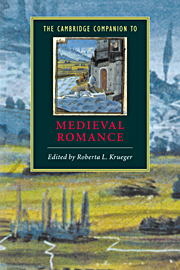Book contents
- Frontmatter
- Introduction
- Part 1 The origins, forms, and contexts of medieval romance
- 1 The shape of romance in medieval France
- 2 Marvels of translation and crises of transition in the romances of Antiquity
- 3 Romance and other genres
- 4 The manuscript context of medieval romance
- Part 2 European romance and medieval society
- Part 3 European transformations
- Editions and translations
- Index
- Series list
1 - The shape of romance in medieval France
from Part 1 - The origins, forms, and contexts of medieval romance
Published online by Cambridge University Press: 28 May 2006
- Frontmatter
- Introduction
- Part 1 The origins, forms, and contexts of medieval romance
- 1 The shape of romance in medieval France
- 2 Marvels of translation and crises of transition in the romances of Antiquity
- 3 Romance and other genres
- 4 The manuscript context of medieval romance
- Part 2 European romance and medieval society
- Part 3 European transformations
- Editions and translations
- Index
- Series list
Summary
The shape of romance in medieval France compels, even as it escapes, our urge to define it. This fundamental dichotomy contributes in no small measure to the vitality and appeal of medieval romance from its start in the mid-twelfth century, when French verse romances introduce a new literary type and set up models that will be vigorously imitated and reinvented by romancers for centuries thereafter. To follow this development, we need to analyze closely not only specific shapes but the art of shaping that gives romance its characteristic traits. The self-reflexivity of romance form calls our attention to the way stories are put together in writing by authors who enjoin the reader to admire the work’s shape, its conjointure, as a source of pleasure, but no less as a source of meaning.
If shape is paramount in defining romance, it is in part because romance is the shape-shifter par excellence among medieval genres, a protean form that refuses to settle into neat boundaries prescribed by modern critics. If we line up a spectrum of medieval literary types, we can distinguish romance from saints’ lives, epic, lyric, short tales, all contemporary competitors for audience attention. But we also have to account for the way romance interacts with and even co-opts these other forms and materials. Romances may end after 3000 verses like Floire et Blancheflor or stretch to 30,000 like the Roman de Troie – with a variety of intermediate sizes in between. Eight-syllable rhyming couplets dominate the linear narrative of romance, but occasionally give way to ten- or twelve-syllable lines and epic or lyric stanzas. From the thirteenth century on, verse competes with prose, as the pattern of change itself remains the major constant of the romance genre.
- Type
- Chapter
- Information
- The Cambridge Companion to Medieval Romance , pp. 13 - 28Publisher: Cambridge University PressPrint publication year: 2000
- 5
- Cited by



